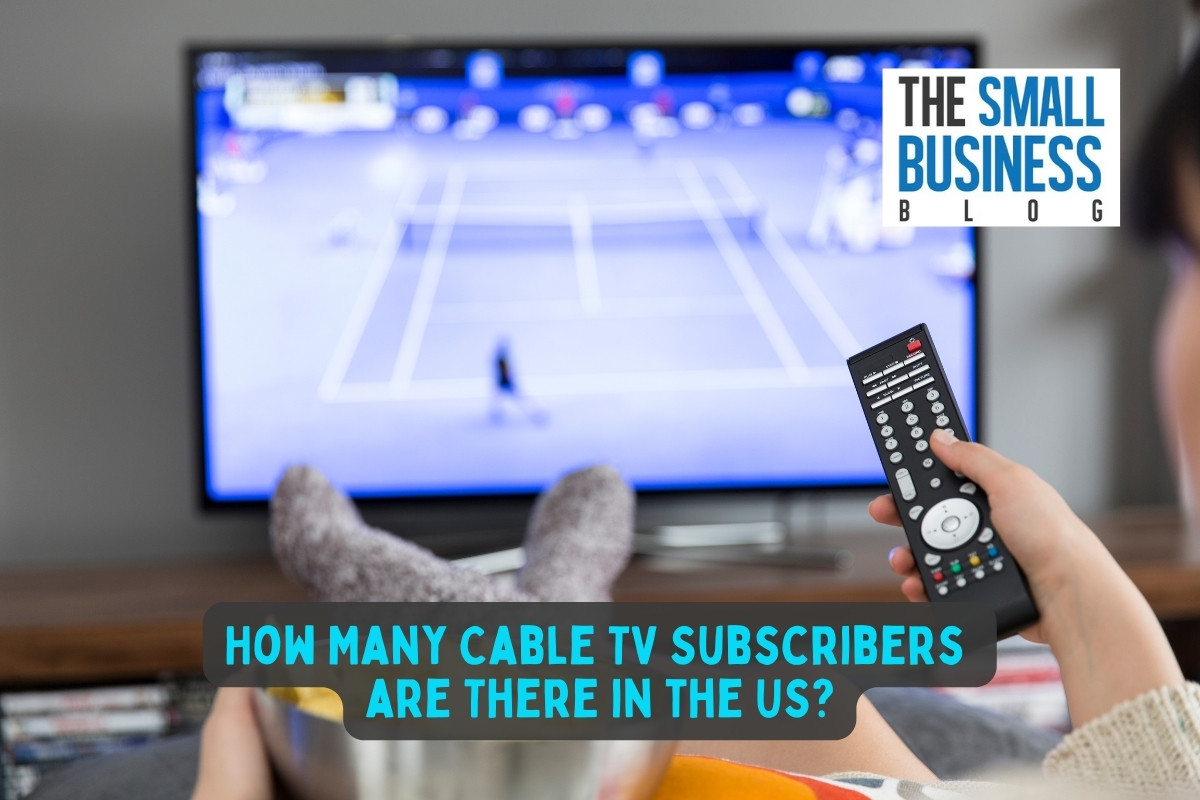Cable T.V. became available in the U.S. in 1948 and it began in some remote areas of Pennsylvania, Arkansas, and Oregon to help households in remote areas gain access to better television reception.
CATV was the name for it at the time.
Over 40 years later in 1989, 53 million homes enjoyed cable television via subscriptions.
By 1992 60% of households in the United States used paid cable television subscriptions.
In the 2010s cable subscriptions were down as technology like streaming media entered the picture.
How many cable TV subscribers are there in the U.S. today?
That’s the topic we will be covering in this article.
We will provide data and statistics that show the growth and/or lack of growth in the cable T.V. industry.
We will also discuss paid streaming services and how they’re doing in today’s climate.
Let’s explore the cable industry and find out how people are engaging with television shows, movies, and other video formatted entertainment today.
Post Contents
- 1 Key Statistics
- 2 How Many Cable TV Subscribers are There in the US?
- 2.1 1. In 2023, there are 75.5 million pay TV subscribers in the United States.
- 2.2 2. Cable, internet TV providers, and Satellite TV entered a downturn early in 2023.
- 2.3 3. In 2016, there were 98.7 million cable TV subscribers.
- 2.4 4. Pay TV is expected to grow to $209.01 billion (USD) by 2030.
- 2.5 5. During the 2022 to 2023 TV season there were 123.8 million households in America watching TV.
- 2.6 6. In 2022, 53% of American households never had cable.
- 2.7 7. In the second quarter of 2023, Comcast lost over 500,000 subscribers.
- 2.8 8. FuboTV lost 118,000 subscribers in the second quarter of 2023.
- 2.9 9. Ad revenue accounted for over 75% of cable and satellite tv providers.
- 2.10 10. Cable TV subscriptions peaked in 2010 at 105 million subscribers.
- 3 FAQs
- 4 Conclusion
Key Statistics
- In 2023, there are 75.5 million pay TV subscribers in the United States.
- Cable, internet TV providers, and Satellite TV entered a downturn early in 2023.
- In 2016, there were 98.7 million cable TV subscribers.
- Pay TV is expected to grow to $209.01 billion (USD) by 2030.
- During the 2022 to 2023 TV season there were 123.8 million households in America watching TV.
- In 2022, 53% of American households never had cable.
- In the second quarter of 2023, Comcast lost over 500,000 subscribers.
- FuboTV lost 118,000 subscribers in the second quarter of 2023.
- Ad revenue accounted for over 75% of cable and satellite tv providers.
- Cable TV subscriptions peaked in 2010 at 105 million subscribers.
How Many Cable TV Subscribers are There in the US?

1. In 2023, there are 75.5 million pay TV subscribers in the United States.
Variety Magazine reports that pay television in the United States had 75.5 million subscribers at the end of the first quarter of 2023.
For perspective, that’s a decrease of 7% over the year before.
Along with the pay TV industry, Hulu, YouTube TV, and other like services saw a decrease of 58.5% over the past year.
(Variety Magazine Online)
2. Cable, internet TV providers, and Satellite TV entered a downturn early in 2023.
Variety also reported that overall, cable, internet TV, and Satellite TV providers have experienced a downturn in subscribers early in 2023.
In fact, they lost 2.3 million customers just in the first quarter of 2023.
In the second quarter of 2023, internet TV providers like Sling and Fubo TV also lost subscribers.
YouTube TV is the only one that gained subscribers in 2023 so far.
(Variety Magazine Online)
3. In 2016, there were 98.7 million cable TV subscribers.
We can see how cable TV subscribers declined between 2016 and 2022 from the following data.
In 2016, 98.7 households subscribed to cable TV.
In 2023, there are 72.2 million cable TV subscribers.
Conversely, Pay TV is expected to see a rise in subscribers.
(Gitnux)
4. Pay TV is expected to grow to $209.01 billion (USD) by 2030.

While cable TV subscriptions have declined, the Pay TV market is expected to take an upturn.
In 2020, the Pay TV market accounted for $184.09 billion (USD).
By 2030, Pay TV is expected to reach $209.01 billion (USD) Pay TV includes programming from premium channels like HBO, Showtime, Cinemax, and Starz for reference.
(Gitnux)
5. During the 2022 to 2023 TV season there were 123.8 million households in America watching TV.
Statista estimates that there are 123.8 million “TV homes” in the United States during the 2022 to 2023 TV season.
This is mostly due to consumers “cutting the cord”, or “unplugging” from services like cable and other Pay TV services.
Also, people are using other devices to stream movies and television, which has also caused a decline in TV purchases.
(Statista)
6. In 2022, 53% of American households never had cable.
More than half of TV households in the United States never had a cable TV subscription in 2022.
Data shows that nearly 53% of these households said they never had a cable subscription in 2022.
Increased costs of cable and pay TV and the growth of technology like smartphones and tablets may play a role in this decline.
(EnterpriseAppsToday)
7. In the second quarter of 2023, Comcast lost over 500,000 subscribers.
According to data from Leichtman, Comcast lost 543,000 subscribers in the second quarter of 2023.
Likewise, DirecTV lost 400,000, Charter lost 200,000, and Dish TV lost 197,000 subscribers.
This downturn may be caused due to the uptake in cable TV alternatives and in tablet and smartphone usage for watching movies and TV.
(Hollywood Reporter)
8. FuboTV lost 118,000 subscribers in the second quarter of 2023.

Cable TV services aren’t the only companies who lost subscribers this year.
Even paid streaming services lost subscribers this year.
For instance, Fubo TV lost 118,000 subscribers in the second quarter of 2023.
Hulu+ and Hulu Live TV lost 100,000 and Sling TV lost 97,000 subscribers.
Altice lost 69,900 subscribers while YouTube TV gained 200,000 subscribers in the second quarter of 2023.
Did the subscribers move to YouTube TV?
Maybe some of them did, but maybe others just went with free streaming services.
(Hollywood Reporter)
9. Ad revenue accounted for over 75% of cable and satellite tv providers.
Since a high penetration of cable and satellite TV subscribers live in rural areas, ad revenue accounted for over 75% of cable and satellite TV revenues in 2022.
Subscribers aren’t the only revenue source for paid cable and satellite television providers.
They also get a share of the ad dollars from cable and satellite TV networks watched in rural homes.
(Gitnux)
10. Cable TV subscriptions peaked in 2010 at 105 million subscribers.
Cable TV enjoyed its first and last peak of 105 million subscribers in 2022.
In 2020, there were 78.7 million cable TV subscribers in the United States.
This shows the decline occurred well before the global pandemic.
(Gitnux)
FAQs
How Much Does Cable TV Service Cost?
Cable television costs vary between providers.
On average a basic package may start at about $50 per month.
More comprehensive cable TV packages can cost $100 or more each month.
Some cable providers offer bundles that cost less for a year or two and many offer discounts to attract new subscribers.
Spectrum offers bundles that include cable, internet, and phone for instance.
What are the Types of Cable TV Packages?
Cable TV packages can be offered in a variety of packages or bundles, depending on the service provider.
They offer packages that include basic cable channels, premium channels, sports channels, and on-demand content options.
You may even find cable companies that let you choose the channels you want to include.
What are Some Advantages and Disadvantages of Cable TV?
One of the main advantages that appeal to cable subscribers is the variety of channels you can get like your local channels, prime time channels (ABC, CBS, NBC), and sports, news, and entertainment channels.
Cable TV can also include high-quality audio and video along with live TV or on-demand content.
The primary disadvantage of cable TV is the cost.
It can be expensive to subscribe to cable television services. Even when you choose basic cable, it can be costly.
It depends on what you want from cable and if you prefer alternatives for watching movies and TV programming.
What are Alternatives to Cable TV?
Since the early 2010s, alternatives to cable television have cropped up for people who said they wanted to “unplug”, or “cut the cord” from mainstream cable.
Streaming services like Prime Video from Amazon, Hulu, and Netflix have given people more choices in how they get their entertainment.
There are also other alternatives like satellite television and IPTV.
Satellite TV can be provided by companies like Dish Network or DirectTV.
IPTV may be more affordable than cable, but you don’t get the same options as you do with cable in terms of channels.
Conclusion
Now that we know cable TV subscriptions in the United States are down by about 7% since the first quarter of 2023 with 75.5 million customers.
Of this number, 35.9 million have subscriptions to the top seven cable companies in America.
We learned the fluctuations in the cable industry and the alternatives that people have turned to in the past 10 years or more.
Interestingly, cable and satellite TV providers don’t rely solely on subscribers for revenue.
Have ad revenues kept the cable and satellite TV industry in business?
We also now know that it’s not just cable and satellite TV services that have lost subscribers over the past 10 years or more.
We also saw how the second quarter of 2023 saw subscriber declines at some of the major streaming platforms like Hulu+ and Netflix.
We hope knowing the answer to “how many cable TV subscribers are there in the US” has given you enough information to decide how you want to get your entertainment.






























